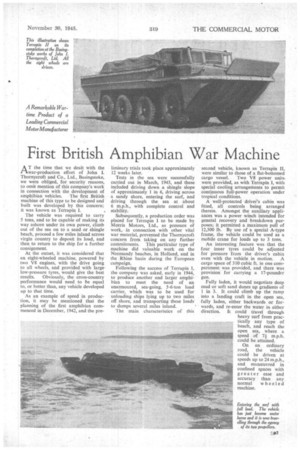First British Amphibian War Machine
Page 29

If you've noticed an error in this article please click here to report it so we can fix it.
AT the time that we dealt with the war-production effort of John I. Thornycroft and Co., Ltd., Basingstoke, we were obliged, for security reasons, to omit mention of this company's work in connection with the development of
amphibian vehicles. The first British machine of this type to be designed and built was developed by this concern; it was known as Terrapin I.
The vehicle was required to carry 5 tons, and to be capable of making its way ashore under its own power, climb out of the sea on to a sand or shingle beach, proceed a few miles inland across virgin country to deposit its load, and then to return to the ship for a further consignment.
• At the outset, it was considered that an eight-wheeled machine, powered by two V8 engines, with the drive going to all wheels, and provided with largelow-pressure tyres, would give the best results. Obviously, the cross-country performance would need to be equal to, or better than, any vehicle developed up to that time.
As an example of speed in production, it may be mentioned that the planning of the first amphibian commenced in December, 1942, and the pre
liminaty trials took place approximately 12 weeks later.
Tests in the sea were successfully carried out in March, 1943, and these included driving down a shingle slope of approximately 1 in 6, driving across a sandy shore, entering the surf, and driving through the sea at about 6 m.p.h., with complete control and stability.
Subsequently, a production order was placed for Terrapin I to be made by Morris Motors, Ltd., as pressure of work, in connection with other vital war material, prevented the Thornycroft concern from taking on any further commitments. This particular type of machine did valuable work on the Normandy beaches, in Holland, and in the Rhine basin during the European campaign.
Following the success of Terrapin I, the company was asked, early in 1944, to produce another and larger amphibian to meet the need of an unarmoured, sea-going, 5-6-ton load carrier, which was to be used for unloading ships lying up to two miles off shore, and transporting these loads
to dumps several miles inland. • The main characteristics of this second vehicle, known as Terrapin II, were similar to those of a flat-bottomed
cargo vessel. Two V8 power units. were provided, as with Terrapin I, with special cooling arrangements to permit continuous full-power operation under tropical conditions.
A well-protected drivel's cabin was fitted, all controls being arranged therein. Amongst the auxiliary appliances was a power winch intended for general recovery and breakdown purposes; it permitted a maximum pull of 12,500 lb. By use of a special A-type frame, the vehicle could be used as a mobile crane for loads up to 3 tons.
An interesting feature was that the four inner tyres could be adjusted for pressure from the driver's cabin even with the vehicle in motion. A cargo space of 310 cubic ft. in one compartment was provided, and there was provision for carrying a 17-pounder gun.
Fully laden, it would negotiate deep mud or soft sand dunes up gradients of 1 in 3. It could climb up the ramp into a landing craft in the open sea, fully laden, either backwards or forwards, and re-enter the water in either direction. It could travel through heavy surf from practically any type of beach, and reach the open sea, where a speed of 7i m.p.h. could be attained.
On an ordinary road, the vehicle could be driven at speeds up to 24 m.p.h., and manceuvred in confined spaces with greater ease and accuracy than any normal wheeled machine.




























































